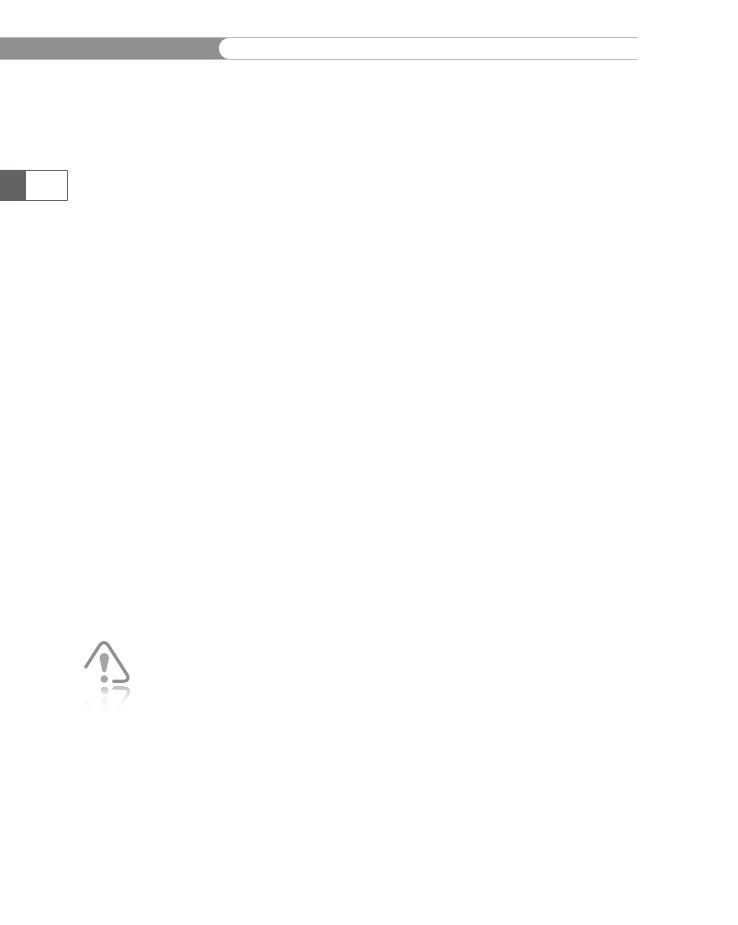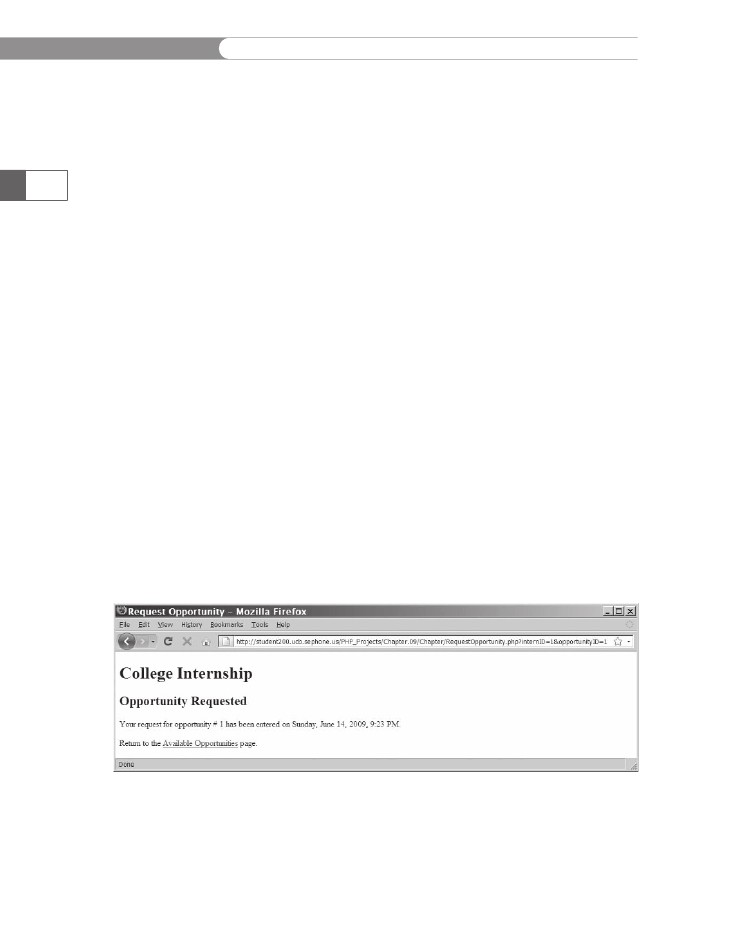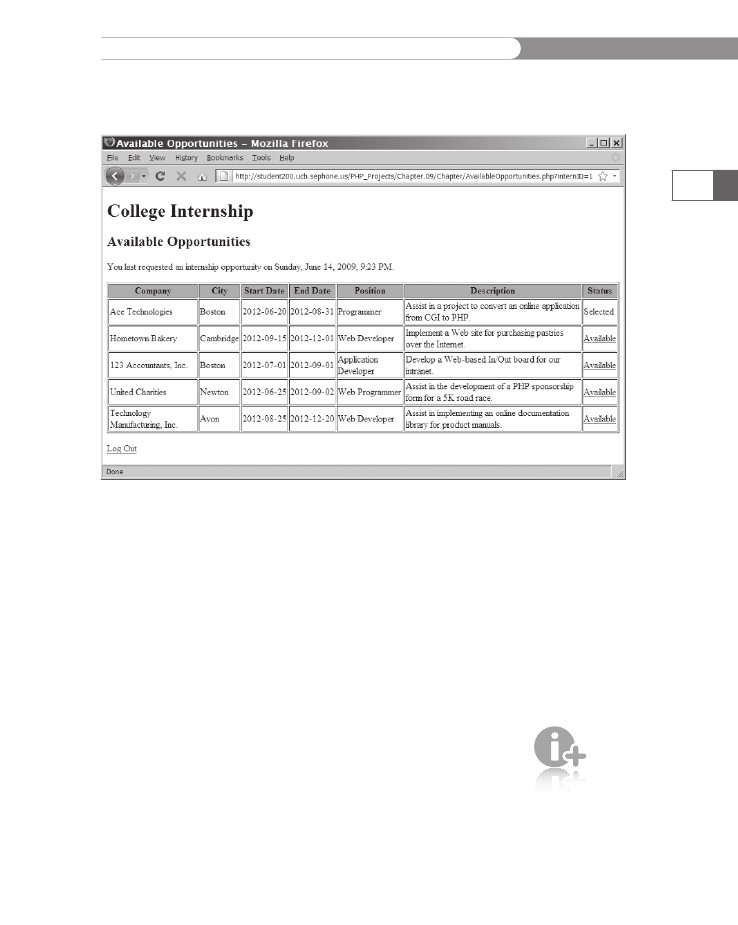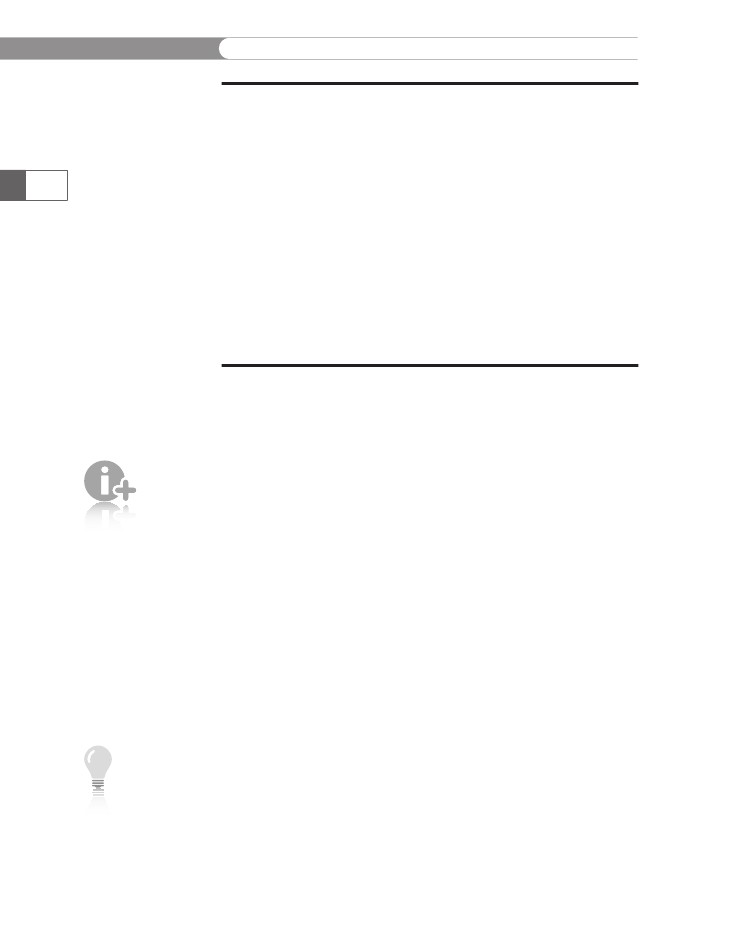
- •Initializing with Constructor Functions . . . . .
- •Into a Web page as a separate section. Although JavaScript code can
- •Is that standard php script delimiters are guaranteed to be available
- •In the block. Any text or lines between the opening /* characters and
- •2.7541 Are not integers; they are floating-point numbers. A floating-
- •Value 300
- •Is a value of 2.5, because 6 goes into 15 exactly 2.5 times. But if you
- •IsEven.Php.
- •Ing example,
- •Ing curly brace is on its own line following the function statements.
- •In php 3 and earlier, it was necessary to put a function definition
- •Is called an iteration. When the conditional expression evaluates
- •Including Files
- •13. Close your Web browser window.
- •Including Files
- •In php, you can also use two operators to combine strings. The first
- •Xhtml source code gen-
- •Input. Php provides several functions for manipulating the case of a
- •Is uppercase. If you need the reverse of ucfirst(), the lcfirst()
- •In some situations, you will need to find and extract characters and
- •Information Interchange, or ascii, which are numeric represen-
- •In comparison, the following preg_match() function returns a value
- •In the pattern is optional. The following code demonstrates how to
- •Values; any strings you validate against a regular expression must
- •Value of 1 because the top-level domain contains a valid value of .Com.
- •Is submitted using the “post” method, the form data is embedded in
- •Validating String Data
- •Xhtml tags or character entities. The message field is a text string
- •Value of the header element. For example:
- •Xhtml code within a php script section.
- •Is typically the person who created the resource. Otherwise, the net-
- •If even a single character of the Web page is sent prior to sending
- •Variables to the file_put_contents() function.
- •Xhtml hyperlink. To download a file from outside the xhtml
- •If...Else statement to display the appropriate version of the mes-
- •Iterating Through an Array
- •Iterating Through an Array
- •In Chapter 2, you learned how to use a foreach statement to iterate
- •Iterating Through an Array
- •Iterating Through an Array
- •In comparison, the following code declares and initializes
- •If ((!file_exists("MessageBoard/messages.Txt"))
- •Values from the array to create a thumbnail gallery of images in which
- •Introduction to Databases
- •Including php, allow you to create Web pages that can read and write
- •Introduction to Databases
- •Information that can be organized into ordered sets of data, and
- •Information. Each recipe in a recipe database, for instance, is a single
- •Introduction to Databases
- •Index, which identifies records in a database to make retrievals and
- •In a single table. However, you might want to break the information
- •Into multiple tables to better organize it into logical sets. Another
- •Information in one of the tables confidential and accessible only by
- •Is the employee information table from Figure 7-1. The related table
- •Is a payroll table that contains confidential salary and compensation
- •Information. Notice that each table contains an identical number of
- •Introduction to Databases
- •Introduction to Databases
- •In a junction
- •Introduction to Databases
- •In a relational format is called a relational database management
- •Is a standard data manipulation language among many dbmSs.
- •Into the query area at the top of the screen or by dragging tables and
- •It is important to understand that even though many dbmSs sup-
- •Introduction to Databases
- •If you ever
- •Is. In comparison, the bigint data type stores integer values between
- •5 Rows in set (0.00 sec)
- •Int);[enter ]
- •Important, these two tabs can cause you to lose all of the data in the
- •Internet Explorer to export the table, click the Save button in the File
- •Ifies the table being changed and the change to make.
- •It easier for you to write php code that can be used with a variety of
- •Information about queries that match one of the following formats:
- •Various types of actions, depending on the type of query.
- •Include fields for the date and time of the flight, flight number, and
- •In the ChineseZodiac folder and upload the file to the server. Open
- •Including white space,
- •Information on a Web server. When you start a new session, the
- •Introduction to Object-Oriented Programming
- •Introduction to Object-Oriented
- •Variables associated with an object are called properties or attributes.
- •In the Loan object example, a function that calculates the number of
- •Introduction to Object-Oriented Programming
- •Introduction to Object-Oriented Programming
- •Include instances of objects inherit the object’s functionality.
- •In this chapter, you will create the Web site for an online order form
- •In an online store application. The application includes information
- •Ity of building a working online store. Online store classes are very
- •Information and products. The OnlineStore class requires that store
- •Information is stored in a table containing six fields: storeId, name,
- •Information. Instead, the class simply uses session iDs to keep track
- •Variable and function as necessary, without bothering with all this
- •In a class
- •Is developed. Imagine what would happen if Microsoft distributed
- •Ing class is invalid because it does not include an access specifier:
- •If they will not be supported by future xhtml versions or are not
- •Xhtml standards. To review the guide of current w3c css specifi-
- •Information to remind yourself or others of what the code is doing. A
- •Xhtml document to the external style sheet. This link informa-
- •If you select Apache from the WampServer menu and select Service
- •Ing code uses the number_format() function to add comma separa-
- •In data that a user submits to a php script.
- •Value of “On” and the display_startup_errors directive is assigned
- •Instead. By looking at the source code, you could see that the value of
- •Ing engine can even help locate logic errors.
- •In Chapter 8, along with the equivalent mssql_* functions, where
- •Inline styles, 632
- •Xhtml, 620–635 (continued)
Including white space,
HTML elements, or output
from the echo or print
statements; otherwise,
you will receive an error.
You can call the setcookie() function multiple times to create addi-
tional cookies—but again, remember that setcookie() statements
must come before any other output on a Web page. The following
example creates three cookies:
setcookie("firstName", "Don");
setcookie("lastName", "Gosselin");
setcookie("occupation", "writer");
PHP also allows you to store cookie values in indexed or associative
arrays by appending array operators ([ ]) and an index or key to the
cookie name within the setcookie() function. The following state-
ments create an indexed cookie array named professional[] that
contains three cookie values:
setcookie("professional[0]", "Don");
setcookie("professional[1]", "Gosselin");
setcookie("professional[2]", "writer");

CHAPTER
9
Managing
State Information
The
following statements create an associative version of the
professional[]
cookie
array:
setcookie("professional['firstName']",
"Don");
setcookie("professional['lastName']",
"Gosselin");
setcookie("professional['occupation']",
"writer");
520
By
default, cookies cannot include semicolons or other special char-
acters
such as commas or spaces, because cookies are transmitted
between
Web browsers and Web servers using HTTP, which does not
allow
certain nonalphanumeric characters to be transmitted in their
native
format. However, you can use special characters in cookies you
create
with PHP because the setcookie()
function
automatically
encodes,
or converts, special characters in a text string to their cor-
responding
hexadecimal ASCII value, preceded by a percent sign. For
example,
20 is the hexadecimal ASCII equivalent of a space character,
and
25 is the hexadecimal ASCII equivalent of a percent sign (%). In
URL
encoded format, each space character is represented by %20,
and
each
percent sign is represented by %25.
After encoding, the contents
of
the string "tip=A
standard tip is 15%" would
read as follows:
tip=A%20standard%20tip%20is%2015%25
Encoding
does not occur for standard alphanumeric characters such as
A,
B, and C or 1, 2, and 3, or for any of the following special
characters:
-
_ . ! ~ *
‘
()
It
also does not encode the following characters that have special
meaning
in a URL:
;
/ ? : @ & = + $ ,
For
example, the backslash (/) character is not encoded because it
is
used for designating a path on a file system. PHP automatically
decodes
special characters when you read cookie values. (You will
learn
how to read cookies later in this chapter.)
The
start of
the opening
PHP tag
must be the
first charac-
ter on the first line of the
file. If anything precedes
the opening PHP tag,
even white spaces or
blank lines, your code will
produce an error.
To modify the New Intern Registration page so that the Intern ID is
stored in a temporary cookie:
1.
Return to the RegisterIntern.php document in your text
editor.
Cut and paste the existing PHP script section above the
<!DOCTYPE> declaration. This is necessary because the
setcookie() function, which you will add later in this
exercise, must be called before any output statements.
Immediately after the opening of the PHP script section, add the
following code to declare and initialize the $Body string variable:
$Body = "";
2.
3.

Using
Cookies to Save State Information
4.
Replace
each occurrence of the echo
statement
with the
$Body
.= assignment
statement. For example, the code:
echo
"<p>You need to enter an e-mail
address.</p>\n";
becomes:
$Body .= "<p>You need to enter an e-mail
address.</p>\n";
521
When develop-
ing a PHP
script, you
may acciden-
tally create,
but not delete, persistent
cookies that your pro-
gram does not need.
Unused persistent cook-
ies can sometimes inter-
fere with the execution of
a PHP script, so you may
want to delete your
browser cookies periodi-
cally, especially while
developing a PHP script
that uses cookies. To
delete cookies in Firefox,
click Tools on the menu
bar and select Options. In
the Options dialog box,
click “Use custom set-
tings for history” in the
“Firefox will:” drop-down
box, and then click the
Show Cookies button.
Highlight the desired
cookie and click the
Remove Cookie button,
or click the Remove All
Cookies button to remove
them all. To delete cook-
ies in Microsoft Internet
Explorer, click Tools on
the menu bar and click
Internet Options. Click the
General tab of the
Internet Options dialog
box, and then click the
Delete button in the
Browsing history section.
In the next dialog box,
click the Delete cookies
button.
5.
Add the following setcookie() statement above the
mysql_close() statement at the end of the script section.
This statement creates a new cookie named internID that
contains the newly assigned Intern ID.
setcookie("internID", $InternID);
6.
Within the <body> tags, add the following PHP script to
display the output generated by the previous PHP script:
<?php
echo $Body;
?>
7.
Save the RegisterIntern.php document and upload it to the
Web server.
The expires Argument
For a cookie to persist beyond the current browser session, you
must use the expires argument with the setcookie() function.
You might use a cookie that expires after one week or less to store
data that needs to be maintained for a limited amount of time. For
example, a travel agency may store data in a cookie that temporarily
holds a travel reservation until it expires after one week. Or, an online
retail site may store shopping cart information in cookies that expire
after only 15 minutes. The expires argument determines how long
a cookie can remain on a client system before it is deleted. Cookies
created without an expires argument are available for only the cur-
rent browser session. You assign to the expires argument a value
representing the date or time when the client system is to delete the
cookie. Use PHP’s time() function to return the current time and add
to it an integer in seconds to specify the time to delete the cookie. The
following setcookie() function specifies that the firstName cookie
expires in 3600 seconds, or one hour from now:
setcookie("firstName", "Don", time()+3600);
By multiplying the number of seconds in a minute and an hour, and
then multiplying that value by the necessary number of hours or days,

CHAPTER
9
The
following
steps use the
versions of
Firefox and
Internet
Explorer for Windows that
were available when this
book was published.
Different systems and
versions have different
procedures.
Managing State Information
you can specify an expiration time more easily. The following example
specifies that the firstName cookie expires in one week by multiplying
the number of seconds in a minute (60), the number of minutes in an
hour (60), the number of hours in a day (24), and then the number of
days in a week (7).
setcookie("firstName", "Don", time()+(60*60*24*7));
522
To create the Request Opportunity page, which creates a persistent
cookie containing the date of the visitor’s last selection:
1.
Create a new document in your text editor and type the
<!DOCTYPE> declaration, <html> element, header informa-
tion, and <body> element. Use the strict DTD and “Request
Opportunity” as the content of the <title> element.
Add the following text and elements to the document body:
<h1>College Internship</h1>
<h2>Opportunity Requested</h2>
<?php
echo $Body;
?>
The
script
section
will
contain a
setcookie() function,
so be sure to create the
script section above the
opening <!DOCTYPE>
declaration; otherwise,
you will receive an error.
2.
3.
Add a script section above the opening <!DOCTYPE>
declaration:
<?php
?>
4.
Add the following statements to the script section to validate
the submitted data:
$Body = "";
$errors = 0;
$InternID = 0;
if (isset($_GET['internID']))
$InternID = $_GET['internID'];
else {
$Body .= "<p>You have not logged in or
registered. " .
" Please return to the " .
" <a href='InternLogin.
php'>Registration / " .
" Log In page</a>.</p>";
++$errors;
}
if ($errors == 0) {
if (isset($_GET['opportunityID']))
$OpportunityID = $_GET['opportunityID'];
else {
$Body .= "<p>You have not selected an
opportunity. " .
" Please return to the " .
" <a href='AvailableOpportunities.
php?" .
Using
Cookies to Save State Information
"internID=$InternID'>Available
" .
"
Opportunities page</a>.</p>";
++$errors;
}
}
5.
Add
the following statements to the end of the script sec-
tion
to connect to the database server and open or create the
internships
database.
Be sure to replace host
with
the name
of
your MySQL server, and user
and
password
with
your user
name
and password.
if
($errors == 0) {
$DBConnect
= @mysql_connect("host", "user",
"password");
if ($DBConnect === FALSE) {
$Body .= "<p>Unable to connect to the
database " .
" server. Error code " . mysql_
errno() . ": " .
mysql_error() . "</p>\n";
++$errors;
}
else {
$DBName = "internships";
$result = @mysql_select_db($DBName,
$DBConnect);
if ($result === FALSE) {
$Body .= "<p>Unable to select the
database. " .
"Error code " . mysql_
errno($DBConnect) .
": " . mysql_error($DBConnect)
. "</p>\n";
++$errors;
}
}
}
523
6.
Add the following statements to the end of the script
section to mark the opportunity as selected in the
assigned_opportunities table and close the database con-
nection. The date() function is used to return the current
date and time as a formatted string. For the $DisplayDate
variable, the format string "l, F j, Y, g:i A" creates a
date string in a user-friendly format; the day of the week, the
month name, and the day and year are followed by the time as
hours and minutes AM or PM. For the $DatabaseDate vari-
able, the format string "Y-m-d H:i:s" creates a date string
in the format MySQL uses: “yyyy-mo-dd hh:mi:ss”, where
yyyy is a four-digit year, mo is a two-digit month, dd is a two-
digit day of the month, hh is a two-digit number indicating
CHAPTER
9
Managing
State Information
the
hours since midnight, mi
is
a two-digit minute, and ss
is
a
two-digit
second.
$DisplayDate
= date("l, F j, Y, g:i A");
$DatabaseDate
= date("Y-m-d H:i:s");
if
($errors == 0) {
$TableName
= "assigned_opportunities";
$SQLstring = "INSERT INTO $TableName " .
" (opportunityID, internID, " .
" date_selected) VALUES " .
" ($OpportunityID, $InternID, " .
" '$DatabaseDate')";
$QueryResult = @mysql_query($SQLstring,
$DBConnect) ;
if ($QueryResult === FALSE) {
$Body .= "<p>Unable to execute the query. " .
" Error code " . mysql_
errno($DBConnect) .
": " . mysql_error($DBConnect) .
"</p>\n";
++$errors;
}
else {
$Body .= "<p>Your request for opportunity
# " .
" $OpportunityID has been
entered " .
" on $DisplayDate.</p>\n";
}
mysql_close($DBConnect);
}
524
7.
Add the following statements to the end of the script section
to provide a link back to the Available Opportunities page if
the Intern ID is valid, or to the Registration/Log In page if the
Intern ID is not valid.
if ($InternID > 0)
$Body .= "<p>Return to the <a href='" .
"AvailableOpportunities.
php?internID=$InternID'>" .
"Available Opportunities</a> page.</p>\n";
else
$Body .= "<p>Please <a href='InternLogin.
php'>Register " .
" or Log In</a> to use this page.</p>\n";
8.
Add the following statements to the end of the script section
to create a persistent cookie named LastRequestDate. The
urlencode() function is used because of the special charac-
ters needed for the date and time. The cookie is set to expire
one week from now.

Using
Cookies to Save State Information
if
($errors == 0)
setcookie("LastRequestDate",
urlencode($DisplayDate),
time()+60*60*24*7);
9.
Save the document as RequestOpportunity.php in the
Chapter directory for Chapter 9 and upload the file to the
Web server.
525
The path Argument
The path argument determines the availability of a cookie to other
Web pages on a server. By default, a cookie is available to all Web
pages in the same directory. However, if you specify a path, a cookie is
available to all Web pages in the specified path and in all its subdirec-
tories. For example, the following statement makes the cookie named
firstName available to all Web pages located in the marketing direc-
tory or any of its subdirectories:
setcookie("firstName", "Don", time()+3600, "/marketing/");
To make a cookie available to all directories on a server, use a forward
slash (/) to indicate the root directory:
setcookie("firstName", "Don", time()+3600, "/");
Many different types of Web applications use the same cookie name,
such as username or id. This can cause conflicts if both Web applica-
tions are on the same Web site. Therefore, you should always place
PHP applications that use cookies into their own directory and use
the path argument to specify the directory for that application. This
approach will prevent different applications from changing the same
cookie, which would result in erratic behavior for the scripts.
If you use a
/develop-
ment
directory
when develop-
ing cookie-based PHP
applications, and place
each application in its
own subdirectory of the
/development direc-
tory, you will help avoid
conflicts not only between
PHP applications in devel-
opment, but with other
PHP applications that are
already installed.
The domain Argument
Using the path argument allows cookies to be shared across a
server. Some Web sites, however, are very large and use a num-
ber of servers. The domain argument is used for sharing cookies
across multiple servers in the same domain. Note that you cannot
share cookies outside of a domain. For example, if the Web server
programming.gosselin.com needs to share cookies with the Web
server writing.gosselin.com, the domain argument for cookies set
by programming.gosselin.com should be set to .gosselin.com.
That way, cookies created by programming.gosselin.com are avail-
able to writing.gosselin.com and to all other servers in the domain
gosselin.com.

CHAPTER
9
Managing
State Information
The
following code shows how to make a cookie at
programming.gosselin.com
available
to all servers in the
gosselin.com
domain:
setcookie("firstName",
"Don", time()+3600, "/",
".gosselin.com");
526
The
secure Argument
Internet
connections are not always considered safe for transmitting
sensitive
information. Unscrupulous people can steal personal infor-
mation
online, such as credit card numbers, passwords, and Social
Security
numbers. To protect private data transferred across the
Internet,
Netscape Communications developed Secure Sockets Layer,
or
SSL, to encrypt and transfer data across a secure connection. URLs
for
Web pages that support SSL usually start with https:
instead
of
http:.
The secure
argument
indicates that a cookie can only be
transmitted
across a secure Internet connection using HTTPS or
another
security protocol. To use this argument, you assign a value of
1
(for TRUE)
or 0 (for FALSE)
as the last argument of the setcookie()
function.
For example, to specify the secure
attribute
for a cookie,
you
use a statement similar to the following:
Elements
of the
$_COOKIE[]
autoglobal
array are
also automatically
assigned to the
$_REQUEST[] auto-
global array, along with
all of the elements of the
$_POST[] and
$_GET[] autoglobal
arrays.
setcookie("firstName", "Don", time()+3600, "/",
".gosselin.com", 1);
Reading Cookies
Cookies that are available to the current Web page are automati-
cally assigned to the $_COOKIE[] PHP autoglobal array. You can then
access each cookie by using the cookie name as a key in the associa-
tive $_COOKIE[] array. (Recall that autoglobals are associative arrays.)
The following statement displays the value assigned to the firstName
cookie:
echo $_COOKIE['firstName'];
When you create a cookie with the setcookie() function, the cookie
is not available to the current Web page until you reload it. For
example, the following statement causes an error when the Web page
first loads because you cannot access the firstName, lastName, and
occupation cookies until you reload the Web page:
setcookie("firstName", "Don");
setcookie("lastName", "Gosselin");
setcookie("occupation", "writer");
echo "{$_COOKIE['firstName']} {$_COOKIE['lastName']} is a
{$_COOKIE['occupation']}.";
Using
Cookies to Save State Information
To
ensure that a cookie is set before you attempt to use it, you can
use
the isset()
function,
the same as when you check whether form
variables
contain values.
setcookie("firstName",
"Don");
setcookie("lastName",
"Gosselin");
setcookie("occupation",
"writer");
if
(isset($_COOKIE['firstName'])
&&
isset($_COOKIE['lastName'])
&& isset($_COOKIE['occupation']))
echo "{$_COOKIE['firstName']} {$_COOKIE['lastName']}
is a {$_COOKIE['occupation']}.";
527
When you store cookies in indexed or associative arrays, PHP
stores the cookies as two-dimensional arrays within the $_COOKIE[]
autoglobal. Therefore, you must use multidimensional array syntax
to read each cookie value. You refer to cookie arrays by using the
cookie name as the first dimension and each index or key that rep-
resents a cookie value as the second dimension. For example, the
following statements create and display an indexed version of the
professional[] cookie array:
setcookie("professional[0]", "Don");
setcookie("professional[1]", "Gosselin");
setcookie("professional[2]", "writer");
if (isset($_COOKIE['professional']))
echo "{$_COOKIE['professional'][0]}
{$_COOKIE['professional'][1]} is a
{$_COOKIE['professional'][2]}.";
The following statements create and display an associative version of
the professional[] cookie array:
setcookie("professional[firstName]", "Don");
setcookie("professional[lastName]", "Gosselin");
setcookie("professional[occupation]", "writer");
if (isset($_COOKIE['professional']))
echo "{$_COOKIE['professional']['firstName']}
{$_COOKIE['professional']['lastName']} is a
{$_COOKIE['professional']['occupation']}.";
To modify the Available Opportunities page so that it reads the stored
LastRequestDate cookie:
1.
Return to the AvailableOpportunities.php document in
your text editor.
Add the following statements, which read the
LastRequestDate cookie from the $_COOKIE[] autoglobal
array, immediately after the statement that retrieves the
Intern ID from the $_REQUEST[] autoglobal array. You need
both sets of code because the Registration/Log In page still
uses a query string to log in existing users.
2.

CHAPTER
9
Managing
State Information
if
(isset($_COOKIE['LastRequestDate']))
$LastRequestDate
= $_COOKIE['LastRequestDate'];
else
$LastRequestDate = "";
3.
528
Add the following statements above the statements that dis-
play the table of opportunities. This code displays the value of
the LastRequestDate cookie if it is set.
if (!empty($LastRequestDate))
echo "<p>You last requested an internship
opportunity " .
" on $LastRequestDate.</p>\n";
4.
Save the AvailableOpportunities.php document and upload it
to the Web server.
Open the InternLogin.php file in your Web browser by
entering the following URL: http://<yourserver>/PHP_
Projects/Chapter.09/Chapter/InternLogin.php. In the Return-
ing Intern Login form, enter the e-mail address and password
that you registered with the New Intern Registration form
and click the Log In button. You should see the same “Wel-
come Back” Web page.
Click the Available Opportunities link to open the Avail-
able Opportunities page. The page should open just as it did
before.
Click the Available link in the Status column of one of the
opportunities to open the Request Opportunity page. You
should see an acknowledgement message like the one shown
in Figure 9-8.
5.
6.
7.
Figure 9-8
Request Opportunity Web page displaying a successful request
8.
Click the Available Opportunities link to open the Available
Opportunities page. The page should now show the oppor-
tunity as “Selected” and should display the time of your last

Using
Cookies to Save State Information
selection
above the table. Figure 9-9 shows that Opportunity 1
was
selected.
529
Figure
9-9
9.
Available
Opportunities Web page displaying text from a persistent cookie
Close
your Web browser window.
Deleting
Cookies
You
do not need to delete temporary cookies because they automati-
cally
cease to exist when the current browser session ends. Persistent
cookies
are also automatically deleted when the time assigned to
the
setcookie()
function’s
expires
argument
elapses. To delete a
persistent
cookie before the time assigned to the expires
argument
elapses,
set the value to an empty string and assign a new expiration
value
to a time in the past. You do this by subtracting any number of
seconds
from the time()
function.
The following statements delete
the
firstName,
lastName,
and occupation
cookies
by subtracting 3600
seconds
(one hour) from the current time:
setcookie("firstName",
"", time()−3600);
setcookie("lastName",
"", time()−3600);
setcookie("occupation",
"", time()−3600);
If
you do not
set the value
to an empty
string, the
old value will
persist until you close the
Web browser.

CHAPTER
9
Managing
State Information
Short
Quiz
1.
530
Detail
the differences between temporary cookies and persis-
tent
cookies.
Describe
three limitations of cookies.
Explain
why the setcookie()
function
must be called before
any
output is sent to the browser.
Why
is it important to set the expiration date of a cookie in
a
script when you might want to greet the user by name the
next
time he or she visits the Web?
What
is the purpose of the domain argument?
2.
3.
4.
5.
Using
Sessions to Save State
Information
Many
clients
do not
accept cook-
ies due to
the rampant
rise of spyware, which is
malicious software that
gathers user information
from a local computer for
marketing and advertising
purposes without the
user’s knowledge. Users
increasingly choose to
disable cookies to pre-
vent spyware from gath-
ering user information
from stored cookies.
Cookies are a common state preservation technique used by various
Web development tools in addition to PHP. However, several security
issues are involved with saving state in cookies on a client computer.
First, you cannot ensure the security of every client computer on
which your PHP scripts will run. This means that any private infor-
mation stored in cookies, including Social Security numbers and
credit card information, may be accessible by hackers. Because of
these risks, many clients configure their Web browsers not to accept
cookies. (You can disable cookies in every current Web browser.)
Unfortunately, this also disables any cookie preservation code in your
PHP scripts.
PHP offers a more secure alternative to cookies: storing state infor-
mation in sessions. The term session refers to a period of activity
when a PHP script stores state information on a Web server. A ses-
sion is similar to a temporary cookie in that it is only available for the
current browser session. If you want to store state information that
will be available when a client revisits your Web site in the future, you
must use cookies. Sessions are a little harder to use than cookies, but
because sessions store state information on a Web server rather than
on the user’s computer, they are much safer to use—provided you
properly secure your Web server. Another benefit to using sessions is
that they allow you to maintain state information even when clients
disable cookies in their Web browsers.
The php.ini
configuration
file contains
numerous
directives that
you can use to control
how sessions behave in
your environment.
Using
Sessions to Save State Information
Starting
a Session
Whenever
you need to work with sessions in a PHP script, you
must
call the session_start()
function,
which starts a new ses-
sion
or continues an existing one. When you start a new session, the
session_start()
function
generates a unique session ID to identify
the
session. A session
ID is
a random alphanumeric string that looks
something
like 7f39d7dd020773f115d753c71290e11f.
In addition to
generating
a session ID, the session_start()
function
creates a text
file
on the Web server that has the same name as the session ID, pre-
ceded
by sess_.
For example, the session ID text file for the preceding
session
ID would be named sess_7f39d7dd020773f115d753c71290
e11f.
Any variables that are generated for a session are stored on the
Web
server in this text file.
Session
ID text files are stored in the Web server directory specified
by
the session.save_path
directive
in your php.ini configuration file.
The
session_start()
function
does not accept any arguments,
nor
does it return a value that you can use in your script. Instead,
you
simply call the session_start()
function
by itself in your PHP
script,
as follows:
<?php
session_start();
...
531
Like
the setcookie()
function,
you must call the session_start()
function
before you send the Web browser any output, including
white
space, HTML elements, or output from the echo
or
print
state-
ments.
If any output exists before you call the session_start()
func-
tion,
you receive an error and the function returns a value of FALSE.
If
a client’s Web browser is configured to accept cookies, the
session
ID
is assigned to a temporary cookie named PHPSESSID.
However,
because
you cannot be certain that every client accepts cookies, you
should
also pass the session ID as a query string or hidden form field
to
any Web pages that are called as part of the current session. You
pass
a session ID in a name/value pair of PHPSESSID=session
ID.
You
use
the session_id()
function
to retrieve the session ID for the cur-
rent
session. For example, the following code starts a session and uses
the
session_id()
function
to pass the session ID as a query string to
a
Web page named Occupation.php:
<?php
session_start();
...
?>
<p><a
href='<?php echo "Occupation.php?PHPSESSID="
.
session_id() ?>'>Occupation</a></p>
CHAPTER
9
The
SID
constant
may or may
not be
defined on
your system. It is enabled
through a configuration
setting in the php.ini file.
If SID is not enabled on
your system, use
PHPSESSID as the name
and the return value of
the session_id()
function as the value
instead.
Managing State Information
You can also use the constant SID, which contains a string that con-
sists of "PHPSESSID=" and the session ID. The following example
demonstrates how to use the constant SID to pass the session ID as a
query string to another page:
<?php
session_start();
...
?>
<p><a href='<?php echo "Occupation.php?"
. SID ?>'>Occupation</a></p>
532
For hidden form fields, assign a value of PHPSESSID to the name attri-
bute and use the session_id() function to assign the session ID to
the value attribute of the <input> element, as follows:
<input type="hidden" name="PHPSESSID"
value='<?php echo session_id() ?>' />
To modify the Registration/Log In page so that it uses a session that
tracks the Intern ID number of the current user:
1.
2.
Return to the InternLogin.php document in your text editor.
Insert the following PHP script section above the opening
<!DOCTYPE> declaration:
<?php
?>
3.
Add the following session_start() statement to the begin-
ning of the script section:
session_start();
4.
Modify the action attribute of the two forms so they pass the
session ID in a query string. The modified links should appear
as follows:
<form method="post"
echo SID;
...
<form method="post"
echo SID;
action="RegisterIntern.php?<?php
?>">
action="VerifyLogin.php?<?php
?>">
5.
Save the InternLogin.php document and upload it to the Web
server.
Working with Session Variables
You store session state information in the $_SESSION[] autoglobal.
When you call the session_start() function, PHP either initializes a
new $_SESSION[] autoglobal or retrieves any variables for the current
session (based on the session ID) into the $_SESSION[] autoglobal.
Using
Sessions to Save State Information
For
example, the following code declares and initializes three vari-
ables—firstName,
lastName,
and occupation—in
the $_SESSION[]
autoglobal:
<?php
session_start();
$_SESSION['firstName']
= "Don";
$_SESSION['lastName']
= "Gosselin";
$_SESSION['occupation']
= "writer";
?>
<p><a
href='<?php echo "Occupation.php?"
.
session_id() ?>'>Occupation</a></p>
533
When a user clicks the Occupation link, the firstName, lastName, and
occupation variables are available in the $_SESSION[] autoglobal on
the Occupation.html page. If the Occupation.html page contains the
following script section, it displays Don Gosselin is a writer :
<?php
session_start();
echo "<p>" . $_SESSION['firstName'] . " " .
$_SESSION['lastName']
. " is a " . $_SESSION['occupation'] . "</p>\n";
?>
As with cookies, you can use the isset() function to ensure that a
session variable is set before you attempt to use it, as follows:
<?php
session_start();
if (isset($_SESSION['firstName']) &&
isset($_SESSION['lastName']) &&
isset($_SESSION['occupation']))
echo "<p>" . $_SESSION['firstName'] . " "
. $_SESSION['lastName'] . " is a "
. $_SESSION['occupation'] . "</p>\n";
?>
To modify the New Intern Registration page so that it stores the
Intern ID number in the $_SESSION[] autoglobal:
1.
Return to the RegisterIntern.php document in your text
editor.
Add a session_start() statement to the beginning of the
script section:
session_start();
2.
3.
Locate the statement at the end of the script section that
declares the $InternID variable and modify it so the ID
returned from the mysql_insert_id() function is assigned to
the $_SESSION[] autoglobal, as follows:
$_SESSION['internID'] = mysql_insert_id($DBConnect);
CHAPTER
9
Managing
State Information
4.
Modify
the paragraph element in the document body that dis-
plays
the Intern ID so it refers to the $_SESSION['internID']
autoglobal
variable instead of the $InternID
variable,
as
follows:
$Body
.= "Your new Intern ID is <strong>" .
$_SESSION['internID']
. "</strong>.</p>\n";
534
5.
Replace the code that uses the hidden input in a form with a
link that uses the session ID, as follows:
$Body .= "<p><a href='AvailableOpportunities.php?" .
SID . "'>View Available Opportunities</a></p>\n";
6.
Save the RegisterIntern.php document and upload it to the
Web server.
To modify the Verify Login page so that it stores the Intern ID num-
ber in the $_SESSION[] autoglobal:
1.
2.
Return to the VerifyLogin.php document in your text editor.
Add a PHP script section with a session_start() statement
before the <!DOCTYPE> tag:
<?php
session_start();
?>
3.
Locate the statement at the end of the script section that
declares the $InternID variable and modify it so the
ID returned from the database query is assigned to the
$_SESSION[] autoglobal, as follows:
$_SESSION['internID'] = $Row['internID'];
4.
Replace the code that creates a link that passes the Intern ID
with a link that passes the session ID, as follows:
echo "<p><a href='AvailableOpportunities.php?" .
SID . "'>Available Opportunities</a></p>\n";
5.
Save the VerifyLogin.php document and upload it to the Web
server.
To modify the Available Opportunities page so that it uses the Intern
ID number from the $_SESSION[] autoglobal:
1.
Return to the AvailableOpportunities.php document in
your text editor.
Add a PHP script section with a session_start() statement
before the <!DOCTYPE> tag:
<?php
session_start();
?>
2.
Using
Sessions to Save State Information
3.
Remove
the following code that uses the
$_REQUEST['internID']
element:
if
(isset($_REQUEST['internID']))
$InternID
= $_REQUEST['internID'];
else
$InternID = −1;
535
4.
Modify the three queries that use $InternID so that they use
$_SESSION['internID'] instead, as follows:
$SQLstring = "SELECT * FROM $TableName WHERE " .
" internID='" . $_SESSION['internID] . "'";
...
$SQLstring = "SELECT COUNT(opportunityID) FROM
$TableName " .
" WHERE internID='" . $_SESSION['internID'] . "' " .
" AND date_approved IS NOT NULL";
...
$SQLstring = "SELECT opportunityID FROM $TableName " .
" WHERE internID='" . $_SESSION['internID'] . "'";
5.
Modify the link to RequestOpportunity.php to use the session
ID instead of the Intern ID, as follows:
echo "<a href='RequestOpportunity.php?" .
SID . "&opportunityID=" .
$Opportunity['opportunityID'] .
"'>Available</a>";
6.
Save the AvailableOpportunities.php document and upload it
to the Web server.
To modify the RequestOpportunity.php document so that it uses the
session ID to retrieve user information:
1.
Return to the RequestOpportunity.php document in your
text editor.
Add the following statement to the beginning of the script
section to start the session:
session_start();
2.
3.
Remove the following section that checks the
$_GET['internID'] autoglobal:
if (isset($_GET['internID']))
$InternID = $_GET['internID'];
else {
and replace it with the following if statement that checks the
$_SESSION['internID'] autoglobal:
if (!isset($_SESSION['internID'])) {
CHAPTER
9
Managing
State Information
4.
In
both sections of code that link to the AvailableOpportu-
nities.php
page, replace the Intern ID in the link so that the
session
ID is passed instead, as follows:
$Body
.= "<p>You have not selected an
opportunity.
" .
" Please return to the " .
" <a href='AvailableOpportunities.
php?" .
SID . "'>Available " .
" Opportunities page</a>.</p>";
...
$Body .= "<p>Return to the <a href='" .
"AvailableOpportunities.php?" . SID .
"'>" .
"Available Opportunities</a> page.
</p>\n";
536
5.
Modify the insert query string so it refers to the
$_SESSION['internID'] autoglobal variable instead of the
$InternID variable, as follows:
$SQLstring = "INSERT INTO $TableName " .
" (opportunityID, internID, " .
" date_selected) VALUES " .
" ($OpportunityID, " .
$_SESSION['internID']
. ", '$DatabaseDate')";
6.
Locate the if statement that checks if $InternID is greater
than 0, and modify it to refer to the $_SESSION['internID']
autoglobal variable instead, as follows:
if ($_SESSION['internID'] > 0)
7.
Save the RequestOpportunity.php document and upload it to
the Web server.
Deleting a Session
Although a session automatically ends when the current browser
session ends, sometimes you need to delete a session manually. For
example, you might want to give users the opportunity to end a ses-
sion by clicking a Log Out button or link, or you might want a session
to end if it is inactive for a specified period of time. To delete a ses-
sion, you must perform the following steps:
1.
Execute the session_start() function. (Remember that you
must call the session_start() function whenever you need
to work with sessions in a PHP script.)

Using
Sessions to Save State Information
2.
Use
the array()
construct
to reinitialize the $_SESSION[]
autoglobal.
Use
the session_destroy()
function
to delete the session.
3.
For
example, the following code deletes a session:
<?php
session_start();
$_SESSION
= array();
session_destroy();
?>
537
To
modify the Registration/Log In page so that it deletes any existing
sessions
whenever a user opens it:
1.
2.
Return
to the InternLogin.php document in your text editor.
Add
the following code immediately after the
session_start()
function
in the PHP script section:
$_SESSION
= array();
session_destroy();
3.
Save
the InternLogin.php document and upload it to the Web
server.
Open
the InternLogin.php file in your Web browser by enter-
ing
the following URL: http://<yourserver>/PHP_Projects/
Chapter.09/Chapter/InternLogin.php.
Enter the e-mail
address
and password for a registered user and click the Log
In
button. You should see the Login Successful page. Click the
Available
Opportunities link to open the Available Oppor-
tunities
page. Notice the session ID appended to the URL in
your
browser’s address box.
Click
the Log Out link on the Available Opportunities page to
execute
the session deletion code.
Close
your Web browser window.
4.
5.
6.
Short
Quiz
1.
Describe
two problems with cookies that do not affect
sessions.
Explain
the purpose of the temporary cookie named
PHPSESSID.
How
does the constant SID
pass
the session ID as a query
string
to another page?
2.
3.
CHAPTER
9
Managing
State Information
4.
What
function is used to ensure that the session variable is set
before
you attempt to use it?
What
function must be used when a visitor uses a Log Out
button
to end a session?
5.
538
Summing
Up
•
Information
about individual visits to a Web site is called state
information. Maintaining state means to store persistent informa-
tion about Web site visits.
• To pass form values from one PHP script to another, you can store
the values in hidden form fields, which are submitted along with
other types of form fields.
• One way to preserve information following a user’s visit to a Web
page is to append a query string to the end of a URL. To pass infor-
mation from one Web page to another using a query string, add a
question mark (?) immediately after a URL, followed by the query
string containing the information you want to preserve in name/
value pairs.
• Cookies, also called magic cookies, are small pieces of informa-
tion about a user that are stored by a Web server in text files on
the user’s computer. Cookies can be temporary or persistent.
Temporary cookies remain available only for the current browser
session. Persistent cookies remain available beyond the current
browser session and are stored in a text file on a client computer.
• You use the
setcookie() function to create cookies in PHP. Youmust call the setcookie() function before you send the Web
browser any output, including white space, HTML elements, or
output from the echo or print statements.
• Cookies created with only the
name and value arguments of thesetcookie() function are temporary cookies, because they are
available for only the current browser session.
• For a cookie to persist beyond the current browser session, you
must use the expires argument with the setcookie() function.
• The
path argument of the setcookie() function determines theavailability of a cookie to other Web pages on a server.

Comprehension
Check
•
The
cookie can only be transmitted across a secure Internet connection
using HTTPS or another security protocol.
• To delete a persistent cookie before the time elapses in the
assigned expires argument, assign a new expiration value to a
time in the past and clear the value. You do this by subtracting any
number of seconds from the time() function and setting the value
of the cookie to the empty string.
• Sessions refer to periods of activity when a PHP script stores state
